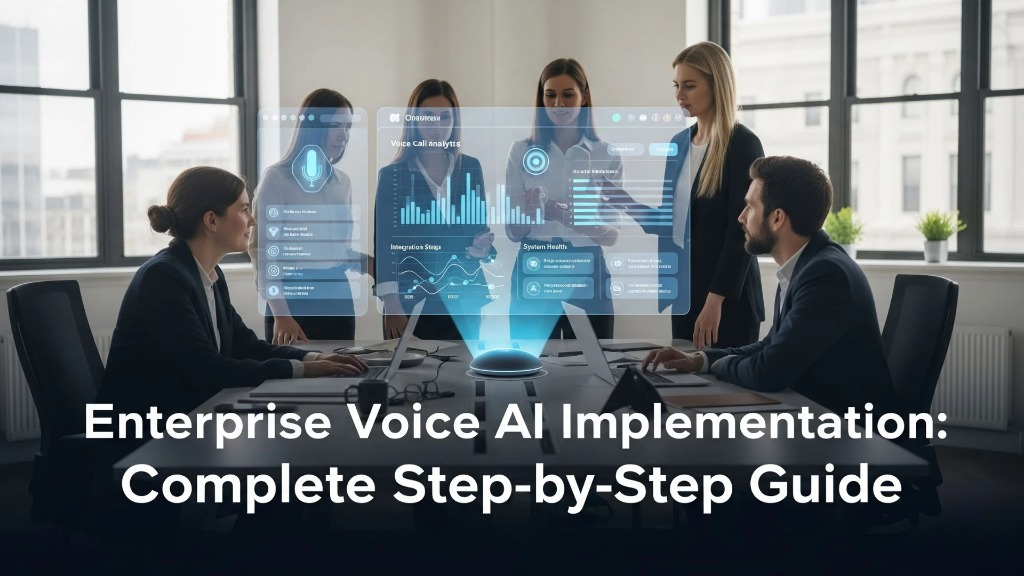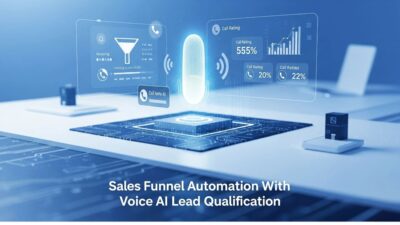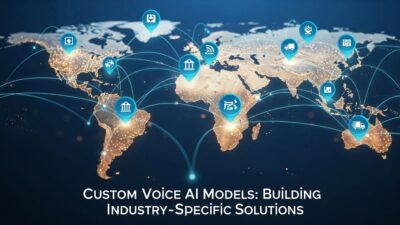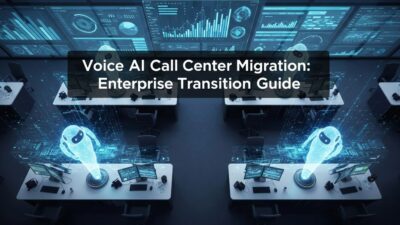Enterprise voice AI implementation requires careful planning and systematic execution for successful deployment. Organizations must evaluate their specific needs before selecting voice AI solutions. Voice technology can transform customer interactions and internal processes significantly. Proper implementation ensures maximum return on investment and user adoption.
Table of Contents
Understanding Enterprise Voice AI Fundamentals
Voice AI technology enables computers to understand and respond to human speech. Natural language processing powers these conversational systems. Machine learning algorithms improve voice recognition accuracy over time. Enterprise applications range from customer service to internal automation.
Voice AI systems process audio input and convert it to text. Natural language understanding interprets user intent accurately. Response generation creates appropriate replies automatically. Text-to-speech technology delivers responses in natural-sounding voices.
Key Components of Enterprise Voice AI Systems
Speech Recognition Engine: The foundation of any voice AI system converts audio to text. Advanced engines handle multiple languages and accents. Background noise filtering improves recognition accuracy. Real-time processing enables immediate responses.
Natural Language Understanding (NLU): NLU components interpret user intentions from spoken words. Context awareness helps systems understand complex queries. Entity extraction identifies important information automatically. Intent classification routes requests to appropriate handlers.
Dialog Management System: Conversation flow management keeps interactions coherent. State tracking remembers conversation context throughout sessions. Multi-turn conversations handle complex user requests. Fallback mechanisms manage unexpected inputs gracefully.
Response Generation and TTS: Automated response creation provides relevant answers quickly. Template-based responses ensure consistency across interactions. Dynamic content generation personalizes user experiences. High-quality text-to-speech creates natural-sounding voices.
Voice AI Implementation Planning Phase
Business Requirements Assessment
Organizations must identify specific use cases for voice AI deployment. Customer service automation often provides the highest immediate value. Internal process automation can reduce operational costs significantly. Employee productivity enhancement creates long-term competitive advantages.
Stakeholder interviews reveal pain points and opportunities. Current process mapping identifies automation candidates. Performance metrics establish baseline measurements. Budget considerations determine implementation scope and timeline.
Technical Infrastructure Evaluation
Existing IT infrastructure must support voice AI requirements. Network bandwidth needs increase with voice processing demands. Server capacity requirements vary by expected usage volume. Cloud vs. on-premises deployment affects infrastructure planning.
Security requirements influence architecture decisions significantly. Data privacy regulations impact storage and processing choices. Integration capabilities with existing systems need careful evaluation. Scalability planning ensures future growth accommodation.
Vendor Selection and Evaluation
Voice AI vendors offer different strengths and specializations. Feature comparison helps identify the best fit. Pricing models vary between vendors and deployment options. Support quality affects long-term implementation success.
Proof of concept testing validates vendor capabilities. Performance benchmarks compare accuracy and speed. Security audits verify compliance with organizational requirements. Reference customer interviews provide real-world insights.
Step-by-Step Voice AI Implementation Process
Phase 1: Infrastructure Preparation
Network and Hardware Setup: Voice AI systems require robust network infrastructure. Bandwidth calculations should account for peak usage periods. Server specifications must handle concurrent voice processing. Load balancing ensures consistent performance under heavy usage.
Security configurations protect voice data throughout processing. Firewall rules allow necessary voice traffic. VPN connections secure remote access requirements. Monitoring tools track system performance continuously.
Integration Architecture Design: API connections link voice AI with existing systems. Database integration enables access to organizational data. CRM connections provide customer context automatically. Workflow automation triggers appropriate business processes.
Testing Environment Setup: Separate testing environments prevent production disruptions. Development sandbox allows safe experimentation. Staging environments mirror production configurations. User acceptance testing validates functionality before deployment.
Phase 2: Voice AI Configuration and Training
System Configuration: Voice recognition settings optimize for organizational needs. Language models train on industry-specific terminology. Accent and dialect customization improves recognition accuracy. Confidence thresholds balance accuracy with responsiveness.
Training Data Preparation: Historical conversation data provides training material. Common queries and responses create knowledge bases. Industry-specific vocabulary enhances understanding capabilities. Regular updates keep training data current.
Model Training and Optimization: Initial model training establishes baseline performance. Iterative improvements refine accuracy over time. A/B testing validates configuration changes. Performance monitoring identifies optimization opportunities.
Phase 3: Pilot Deployment and Testing
Limited Scope Pilot Program: Pilot deployments test systems with real users. Small user groups provide manageable feedback volumes. Specific use cases focus testing efforts effectively. Controlled environments minimize risks during initial deployment.
Performance Monitoring and Metrics: Key performance indicators track system effectiveness. Response accuracy measures voice recognition quality. User satisfaction surveys provide qualitative feedback. Technical metrics monitor system health continuously.
Feedback Collection and Analysis: User feedback identifies improvement opportunities. Error analysis reveals common failure patterns. Performance data guides optimization efforts. Regular reviews ensure continuous improvement.
Phase 4: Full-Scale Enterprise Voice AI Deployment
Phased Rollout Strategy: Gradual rollout minimizes disruption to operations. Department-by-department deployment allows focused support. Regional deployments manage geographic considerations. Feature-by-feature rollout reduces complexity.
Change Management and Training: User training ensures effective voice AI adoption. Change management addresses resistance to new technology. Documentation provides ongoing reference materials. Support channels handle user questions promptly.
Go-Live Support and Monitoring: Dedicated support teams monitor initial deployment. Real-time monitoring catches issues immediately. Escalation procedures handle critical problems quickly. Performance tracking validates successful deployment.
Advanced Voice AI Implementation Strategies
Multi-Language and Global Deployment
International organizations require multi-language voice AI capabilities. Regional accents and dialects need specific configuration. Cultural considerations affect conversation design. Local regulations impact data handling requirements.
Language-specific training improves recognition accuracy. Regional support teams provide localized assistance. Time zone considerations affect global deployment scheduling. Cross-cultural testing validates international effectiveness.
Integration with Existing Enterprise Systems
CRM integration provides customer context automatically. ERP connections enable voice-driven business processes. Help desk integration routes voice requests appropriately. Analytics platforms track voice interaction metrics.
API development connects voice AI with proprietary systems. Data synchronization keeps information current across platforms. Single sign-on integration simplifies user authentication. Workflow automation triggers appropriate business actions.
Advanced Analytics and Optimization
Voice analytics provide insights into user behavior patterns. Sentiment analysis identifies customer satisfaction trends. Conversation mining reveals optimization opportunities. Performance analytics guide system improvements.
Machine learning models improve over time automatically. Predictive analytics anticipate user needs proactively. Real-time optimization adjusts system behavior dynamically. Custom reporting provides business intelligence insights.
Security and Compliance Considerations
Data Protection and Privacy
Voice data contains sensitive personal information. Encryption protects data during transmission and storage. Access controls limit voice data exposure. Regular security audits identify vulnerabilities.
GDPR compliance requires careful voice data handling. Data retention policies govern storage duration. User consent mechanisms ensure legal compliance. Deletion procedures remove data upon request.
Enterprise Security Standards
Voice AI systems must meet enterprise security requirements. Multi-factor authentication protects administrative access. Role-based permissions control system functionality. Security monitoring detects suspicious activities.
Penetration testing validates security measures. Vulnerability assessments identify potential weaknesses. Security patches maintain system protection. Incident response plans address security breaches.
Regulatory Compliance
Industry regulations affect voice AI implementation. Healthcare organizations must comply with HIPAA. Financial services face additional regulatory requirements. Regular compliance audits ensure ongoing adherence.
Audit trails track all voice AI activities. Compliance reporting demonstrates regulatory adherence. Legal review validates implementation approaches. Regular updates maintain compliance with changing regulations.
Performance Optimization and Maintenance
Continuous Improvement Processes
Regular performance reviews identify optimization opportunities. User feedback drives system enhancements. Technical metrics guide infrastructure improvements. Competitive analysis reveals industry best practices.
Monthly performance reports track key metrics. Quarterly reviews assess strategic alignment. Annual evaluations plan major upgrades. Continuous monitoring ensures optimal performance.
System Maintenance and Updates
Regular software updates maintain system security. Performance tuning optimizes resource utilization. Database maintenance ensures data integrity. Backup procedures protect against data loss.
Scheduled maintenance minimizes operational disruption. Emergency procedures handle critical issues. Change management controls system modifications. Documentation tracks all maintenance activities.
Scaling and Growth Planning
Usage growth requires infrastructure scaling. Performance monitoring identifies capacity constraints. Capacity planning ensures adequate resources. Load testing validates scalability assumptions.
Cloud scaling provides flexible resource allocation. On-premises scaling requires hardware planning. Hybrid approaches balance control and flexibility. Cost optimization reduces operational expenses.
Measuring Success and ROI
Key Performance Indicators
Voice AI success requires measurable metrics. Customer satisfaction scores indicate user acceptance. First-call resolution rates measure effectiveness. Average handling time tracks efficiency improvements.
Cost per interaction demonstrates financial benefits. User adoption rates show system acceptance. Error rates indicate system accuracy. Response time measures system performance.
Business Impact Assessment
Voice AI implementation creates measurable business value. Customer service costs often decrease significantly. Employee productivity typically increases substantially. Customer satisfaction scores generally improve.
Revenue impact may include increased sales opportunities. Cost savings come from reduced manual processes. Competitive advantages emerge from improved capabilities. Market differentiation results from enhanced customer experiences.
Long-term Value Realization
Voice AI benefits compound over time. Machine learning improvements enhance capabilities continuously. User adoption increases with system maturity. Integration depth creates additional value opportunities.
Strategic planning ensures continued relevance. Technology roadmaps guide future investments. Innovation opportunities emerge from successful implementations. Organizational capabilities expand with voice AI expertise.
Common Implementation Challenges and Solutions
Technical Challenges
Voice recognition accuracy varies across user populations. Background noise can interfere with system performance. Network latency affects real-time conversation quality. Integration complexity slows deployment timelines.
Comprehensive testing addresses accuracy issues. Noise cancellation technology improves performance. Network optimization reduces latency problems. Phased integration approaches manage complexity.
Organizational Challenges
User resistance can slow adoption rates. Training requirements create resource demands. Change management needs careful planning. Support requirements increase during deployment.
Communication strategies address user concerns. Training programs ensure effective adoption. Change management best practices guide transitions. Support resources scale with deployment needs.
Read More: Automated Customer Outreach: Boost Sales With AI Calls
Budget and Resource Constraints

Voice AI implementation requires significant investment. Technical expertise may be limited internally. Project timelines often extend beyond initial estimates. Ongoing operational costs need careful planning.
Phased approaches spread costs over time. External expertise supplements internal resources. Realistic timelines prevent project pressure. Total cost of ownership guides budget planning.
Enterprise voice AI implementation transforms organizational capabilities when executed properly. Success depends on thorough planning and systematic execution. Organizations that invest in proper implementation see significant returns. The technology continues evolving rapidly, creating new opportunities for competitive advantage.
Voice AI implementation represents a strategic investment in organizational future. Companies that embrace this technology position themselves for long-term success. The benefits extend beyond immediate operational improvements to fundamental business transformation. Careful planning and execution ensure maximum value realization from voice AI investments.






[…] Read More: Enterprise Voice AI Implementation: Complete Step-by-Step Guide […]
[…] appointments become more natural. Patients interact with AI screening systems. Enterprise voice AI solutions protect sensitive information. Medical diagnoses benefit from voice pattern […]
[…] Read More: Enterprise Voice AI Implementation: Complete Step-by-Step Guide […]